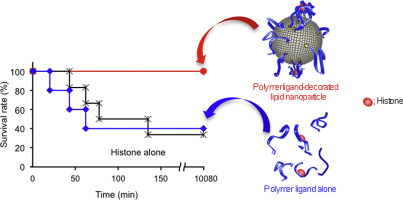Journal of Controlled Release ( IF 10.5 ) Pub Date : 2017-10-20 , DOI: 10.1016/j.jconrel.2017.10.028 Hiroyuki Koide , Hiroki Tsuchida , Masahiko Nakamoto , Anna Okishima , Saki Ariizumi , Chiaki Kiyokawa , Tomohiro Asai , Yu Hoshino , Naoto Oku

|
Many of macromolecular toxins induce cell death by directly interacting with cells or induction of inflammatory cytokines. Abiotic polymer ligands (PLs) composed of functional monomers are able to bind and neutralize toxins in vivo and are of great interest for efficient antidotes. However, little has been reported about recognition and neutralization of target molecules in the bloodstream because of readily elimination from the bloodstream. Here, we report a rational design of PLs-decorated lipid nanoparticles (PL-NPs) for neutralizing a target toxin in vivo. PL that decorated on the NPs would cooperatively interacts with target biomacromolecules since the lipid molecules in NPs have a high degree of freedom. In the present study, N-isopropylacrylamide based PLs interacting with histones, major mediators of sepsis, were synthesized. Affinity between PL-NPs and histones depends on monomer composition and polymer length. The optimized PL-NP showed little affinity for plasma proteins. The PL-NPs inhibited the toxicity of histones both in vitro and in vivo, suggesting that PLs on the NPs cooperatively bound to histones and neutralized their toxicity. In addition, circulation time of optimized PL was significantly prolonged by the modification onto NPs. These results provide a platform for designing antidote nanoparticles neutralizing toxic biomacromolecules.
中文翻译:

合理设计装饰有非生物聚合物配体的解毒剂纳米颗粒,以捕获和中和目标毒素
许多大分子毒素通过与细胞直接相互作用或诱导炎症性细胞因子来诱导细胞死亡。由功能性单体组成的非生物聚合物配体(PLs)能够在体内结合和中和毒素,并且对于有效的解毒剂非常感兴趣。然而,由于易于从血流中消除,因此关于血流中靶分子的识别和中和的报道很少。在这里,我们报告的PLs装饰脂质纳米粒(PL-NPs)的合理设计,用于中和体内的目标毒素。由于NP中的脂质分子具有高度的自由度,因此修饰在NP上的PL将与靶生物大分子协同相互作用。在本研究中,N合成了与组蛋白相互作用的基于β-异丙基丙烯酰胺的PL,组蛋白是败血症的主要介质。PL-NP与组蛋白之间的亲和力取决于单体组成和聚合物长度。优化的PL-NP对血浆蛋白几乎没有亲和力。PL-NPs在体外和体内均能抑制组蛋白的毒性,提示NPs上的PL与组蛋白协同结合并中和了其毒性。另外,通过修饰到NP上,优化的PL的循环时间显着延长。这些结果为设计中和有毒生物大分子的解毒剂纳米颗粒提供了平台。











































 京公网安备 11010802027423号
京公网安备 11010802027423号